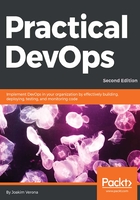
Scrum, Kanban, and the delivery pipeline
How does the CD pipeline that we described in this chapter support Agile processes such as Scrum and Kanban?
Scrum focuses on Sprint cycles, which can occur biweekly or monthly. Kanban can be said to focus more on shorter cycles, which can occur daily.
The philosophical differences between Scrum and Kanban are a bit deeper, although not mutually exclusive. Many organizations use both Kanban and Scrum together.
From a software-deployment viewpoint, both Scrum and Kanban are similar. Both require frequent, hassle-free deployments. From a DevOps perspective, a change starts propagating through the CD pipeline towards test systems and beyond when they are deemed ready enough to start that journey. This may be judged on subjective measurements or objective ones, such as all unit tests are green.
Our pipeline can manage the following types of scenarios:
- The build server supports the generation of objective code quality metrics that we need in order to make decisions. These decisions can either be made automatically or be the basis for manual decisions.
- The deployment pipeline can also be directed manually. This can be handled with an issue management system, via configuration code commits, or both.
So, again, from a DevOps perspective, it doesn't really matter if we use Scrum, Scaled Agile Framework (SAFe®), Kanban, or another method within the lean or Agile frameworks. Even a traditional waterfall process can be successfully managed—DevOps serves all!